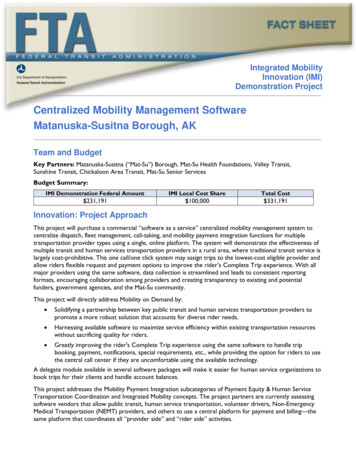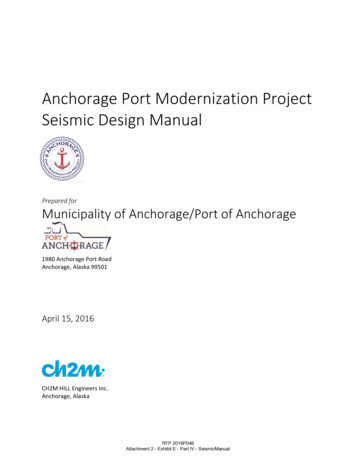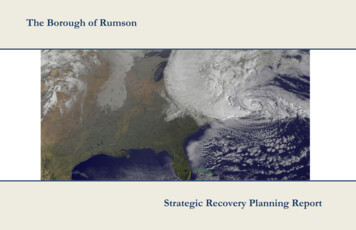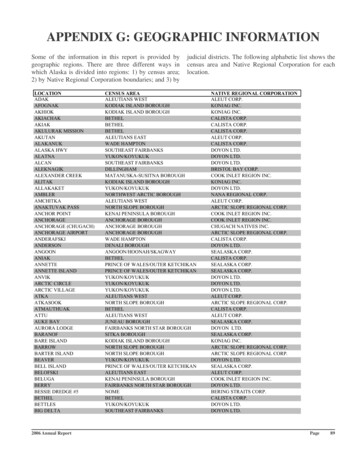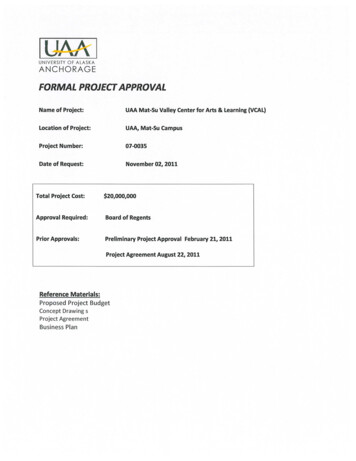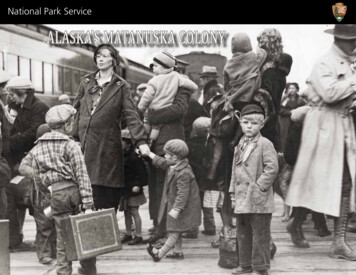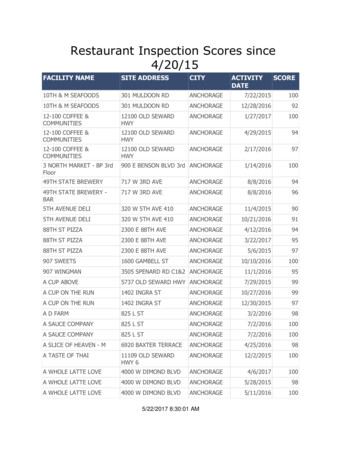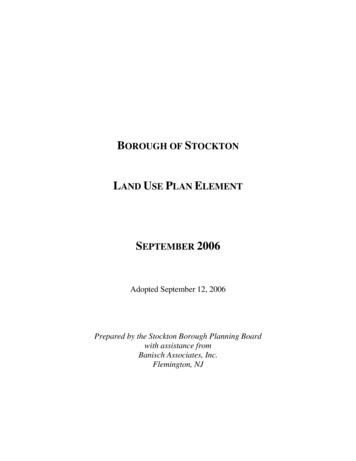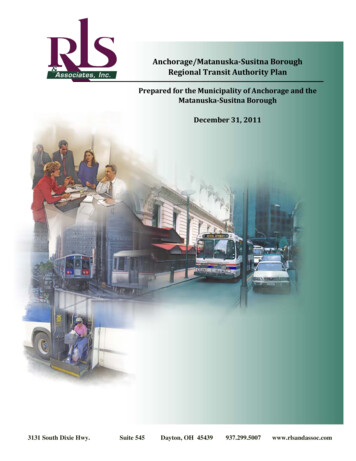
Transcription
Anchorage/Matanuska‐Susitna BoroughRegional Transit Authority PlanPrepared for the Municipality of Anchorage and theMatanuska‐Susitna BoroughDecember 31, 20113131 South Dixie Hwy.Suite 545Dayton, OH 45439937.299.5007www.rlsandassoc.com
Moving Public Transportation Into the FutureRegional Transit Authority PlanTable of ContentsI. Introduction . 1II. Current Public Transportation Services . 2Municipality of Anchorage . 2Mat‐Su Borough . 2III. RTA Organizational Structure . 4Functional Responsibilities . 5Staffing . 6Advantages and Disadvantages . 6IV. Public Outreach . 7V. Recommended Service Plan . 9Short Range . 9Long Range . 19VI. Implementation Plan .27RTA Enabling Legislation . 27VII. Financial Plan .31Appendix A: Task 1 Report . A‐1Appendix B: Task 2 Report . B‐1Appendix C: Task 3 Report . C‐1Appendix D: Recommended Modifications to SB 152 .D‐1Appendix E: Existing RTA Enabling Legislation . E‐1Appendix F: Sample Intermunicipal Agreements. F‐1Appendix G: Sample RTA By‐Laws . G‐1Appendix H: Public Surveys.H‐13131 S Dixie Hwy Dayton, Ohio 45439 937.299.5007 voice 937.299.1055 fax w.rlsandassoc.com
Page Intentionally Left Blank
IntroductionI. INTRODUCTIONThe Municipality of Anchorage in conjunction with the Matanuska‐Susitna (Mat‐Su) Borough contract‐ed with RLS & Associates, Inc. to develop a Regional Transit Authority (RTA) Plan. This Plan examinesthe feasibility of establishing an RTA and will serve as a guide for the management and organizationalstructure for current and future regional public transportation services in Southcentral Alaska. Fourtasks are included in the RTA Plan. These are: A review of regional transit management and governance;An analysis of regional transit service and operations;An analysis of regional transit costs and funding; andThe creation of a Regional Transit Authority Plan and recommendations.The information, findings, and recommendations of each of the first three tasks are discussed intechnical memoranda and included as Appendix A, B, and C. Appendix D contains recommendedmodifications to Senate Bill 152, a requested addition to Task 3. This document is a summary of thefindings and recommendations comprising the Regional Transit Authority Plan. It includes an overviewof existing public transportation services, the recommended organizational structure of a SouthcentralAlaska RTA, a summary of comments made at public meetings and stakeholder interviews, descriptionsof potential RTA‐provided transit services, a financial plan and an implementation plan. This documentincorporates suggestions received from staff and agencies after review of a draft version.There are several public transportation services currently being provided in the Municipality ofAnchorage and Mat‐Su Borough. People Mover and AnchorRIDES are services of the PublicTransportation Department of the Municipality of Anchorage. MASCOT is a service of Mat‐SuCommunity Transit, a private non‐profit agency organized solely to provide public transportationservice to Mat‐Su Borough residents. Valley Mover, a Mat‐Su based private non‐profit, and themunicipality’s Share‐A‐Ride Program provide commuter transportation services between Mat‐SuBorough and Anchorage. A summary of the transportation services provided by these organizationsappears in the following section.This document is draft and confidential. Information contained within is intended only for use by theauthors, RLS & Associates, Inc. and Anchorage/Matanuska‐Susitna Borough. If you are not the intendedrecipient, you are hereby notified that any disclosure, copying, or distribution is strictly prohibitedwithout permission. Thank you.ANCHORAGE/MATANUSKA‐SUSITNA BOROUGH REGIONAL TRANSIT AUTHORITY PLAN1
Page Intentionally Left Blank
Current ServicesII. CURRENT PUBLIC TRANSPORTATION SERVICESMUNICIPALITY OF ANCHORAGEThe Municipality of Anchorage provides public transportation services through its PublicTransportation Department. Three types of services are provided. The table in Exhibit II‐1 outlinesthese services. People Mover is the fixed route service that is operated throughout most of themunicipality. It consists of fourteen (14) routes serving Anchorage, South Anchorage, and Eagle River.AnchorRIDES is the demand response service that includes Americans with Disabilities Act (ADA)complementary paratransit, senior transportation, Medicaid waiver transportation, Eagle RiverConnect, and other coordinated transportation services. The Municipality of Anchorage contracts withMV Transportation for this service. The third type of transportation is vanpool and carpool serviceprovided through the Share‐a‐Ride program. The Municipality of Anchorage contracts with VPSI whichmanages this service.Exhibit II‐1Anchorage Transit ServicesServicePeople MoverAnchorRIDESShare‐a‐RideTypeFixed RouteDemand ResponseRide SharingHours of Operation5:30a‐11:30p5:30a‐11:30pVaries – Can Be Any HoursMAT‐SU BOROUGHWithin Mat‐Su Borough, two entities currently provide public transit services: MASCOT and ValleyMover. Exhibit II‐2 depicts the available transit services. Valley Mover is a private non‐profitorganization which is the recipient of Federal Transit Administration funding. It has been in operationfor about three years and initially provided a for‐profit fixed route service between the Mat‐Su Boroughand Anchorage. It recently became a non‐profit organization and a recipient of Federal TransitAdministration Section 5311 funding for this service in 2011.MASCOT operates public transit services within Mat‐Su Borough. The system consists of demandresponse services, and a deviated fixed route that operates between Palmer and Wasilla. Services areprovided from 5:00 a.m. to 8:00 p.m. and are available to the general public. In addition, the ChickaloonVillage is providing transportation services between the Chickaloon area and Palmer.Exhibit II‐2Mat‐Su Transit ServicesServiceMASCOTValley MoverChickaloon Public TransitTypeRoute Deviation, Demand ResponseIntercity BusRoute DeviationHours of CHORAGE/MATANUSKA‐SUSITNA BOROUGH REGIONAL TRANSIT AUTHORITY PLAN2
The Alaska Railroad Corporation is another provider of passenger service in the region. It operates ser‐vice between Anchorage and Wasilla, Fairbanks, Seward and Girdwood during the summer tourist sea‐son, typically mid‐May to mid‐September. It operates passenger service to Fairbanks weekends onlythrough the winter months. This train operates northbound on Saturday and southbound on Sunday.There are also many human service agencies that provide transportation to specific populations withinthe Municipality of Anchorage and the Mat‐Su Borough. These services are not open to the general pub‐lic and for that reason were not included in this plan.ANCHORAGE/MATANUSKA‐SUSITNA BOROUGH REGIONAL TRANSIT AUTHORITY PLAN3
StructureIII. RTA ORGANIZATIONAL STRUCTUREBased on research conducted of RTA‐enabling statutes that exist in seven other states, and a review ofseven case studies of RTAs that were formed under a state‐enabling statute, four alternativeorganizational structures for a Southcentral Alaska RTA were developed. These are more fullydescribed in Appendix A and include:1.2.3.4.Non‐Operating Overlay DistrictOverlay District/New Service ProviderConsolidated Service ProviderDivision of AMATSThe recommended RTA would be created to provide new transit service(s). The RTA would be multi‐jurisdictional, operating in both Mat‐Su Borough and Anchorage. The existing People Mover, MASCOT,and other organizations and services remain as they are currently. New funding would be needed forthe new structure as well as operating and maintenance of new services. Exhibit III‐1 depicts theorganizational structure of the RTA as an overlay district/new service provider as recommended intask 1 of the study, included as Appendix A.Exhibit III‐1RTA Organizational ChartRTA board members would be appointed by the Mat‐Su Borough and Anchorage Assemblies, who inturn would appoint an executive director. The executive director would oversee an administrativeANCHORAGE/MATANUSKA‐SUSITNA BOROUGH REGIONAL TRANSIT AUTHORITY PLAN4
assistant and manage contracts with one or more transportation service providers. Appendix Eprovides examples of RTA enabling legislation and describes the job descriptions of key staff.FUNCTIONAL RESPONSIBILITIESAn RTA would have the primary responsibility for developing service plans and long‐range transitplans for the region. It would also have grants administration and financial managementresponsibilities as it would administer some FTA transit funding for the region. The Municipality ofAnchorage (MOA), Mat‐Su Borough, MASCOT, and Valley Mover would have responsibility for theoverall management of their transit services, operational planning, transportation operations andmaintenance, and other management functions.RTA‐sponsored service will be contracted with People Mover, MASCOT, private transportationproviders, or other organizations to operate the new transit service. The RTA will not directly operatetransportation services. This has the advantage of avoiding the cost of new facilities for operations andmaintenance. Despite not directly operating any service, the RTA would act as a means to develop jointfares or passes that would allow passengers to transfer seamlessly between services and providers.With the RTA contracting with other entities to provide the new services, the RTA would not have anyresponsibilities in the areas of transportation operations, maintenance, scheduling, safety, or training.It would have oversight and financial management responsibilities since it would administer thefunding used to pay for the new services. The functional responsibilities are outlined in Exhibit III‐2.Exhibit III‐2RTA Functional ResponsibilitiesManagement and ControlRegional Service PlanningLocal Service PlanningRegional Operational PlanningLocal Operational PlanningGrants AdministrationFinancial ManagementPersonnel tion OperationsSafety and TrainingMaintenanceLegalOverlay‐Provide New ServiceMOAMSBRTA ANCHORAGE/MATANUSKA‐SUSITNA BOROUGH REGIONAL TRANSIT AUTHORITY PLAN5
STAFFINGStaffing levels would initially include an executive director and an administrative assistant. It wouldlikely be more cost efficient to contract with a local firm for accounting/bookkeeping services thanhaving an additional person for this function. In time, however, it may be necessary to add anadditional staff member depending on work load.ADVANTAGES AND DISADVANTAGESThe following advantages and disadvantages for an RTA with the described functions were identified.Advantages New funding and new transit services would be provided. The RTA would assume some grants administration, procurement, marketing and other functionsto supplement efforts of the Municipality of Anchorage Public Transportation Department, Mat‐SuBorough, Valley Mover, and MASCOT staff. The operation of new services would take advantage of the capabilities and infrastructure ofexisting public transit providers. Enhanced coordination would result with the influence of an RTA serving jurisdictions that PeopleMover, MASCOT, and Valley Mover already serve.Disadvantages Creating an RTA would require actions at both the state and local levels, however, none have beencommitted at this time. State enabling legislation will need to be passed by the State Legislatureand actions will need to be taken by local governments to create an RTA. It may be difficult to obtain new funding to finance any new transit service.ANCHORAGE/MATANUSKA‐SUSITNA BOROUGH REGIONAL TRANSIT AUTHORITY PLAN6
Page Intentionally Left Blank
OutreachIV. PUBLIC OUTREACHThe RLS & Associates, Inc. team participated in conversations with the groups listed in Exhibit IV‐1during the weeks of December 7, 2010, September 12, 2011, and October 24, 2011. Information aboutthe Regional Transit Authority planning effort provided by the project team consisted of a PowerPointpresentation, a fact sheet, information boards, and a summary of the PowerPoint presentation. Somemeetings were formal, such as the Joint Municipality of Anchorage and Matanuska Susitna BoroughAssembly meeting. Others were informal conversations.Exhibit IV‐1Chronology of Public OutreachDateGroupRepresenting12/02/10AMATS Technical AdvisoryCommittee12/06/10MOA Legal DepartmentMunicipal Traffic, Public Transportation, Public Works,Planning, Health Divisions and Port of AnchorageAlaska Railroad CorporationAlaska Department of Environmental ConservationAlaska Department of Transportation (DOT)Municipality of Anchorage12/06/1012/07/10Joint MOA/MAT‐SU BOROUGHAssembly MeetingCommunity Transportation Coalition12/07/10Mat‐Su Area Legislative Staff12/08/10Highway to Highway Team12/08/10MASCOT Board of Directors12/08/10DOT&PF Statewide Planning12/09/1012/16/10MOA Public Transportation AdvisoryBoardAMATS Policy Committee01/12/11Alaska Mobility CoalitionStatewide transit advocacy group06/13/11MASCOT Board of DirectorsMat‐Su Community Transit Board of Directors09/12/11Staff briefing09/15/11DOT & PF Central Region PlanningStaffMat‐Su Transportation Fair09/16/11Regional Transportation GroupsElected Assembly members from Matanuska SusitnaBorough and Municipality of AnchorageCity of PalmerCity of WasillaCity of Houston (invited)Mat‐Su BoroughMat‐Su Community Transit (MASCOT)Valley MoverAlaska Department of Transportation & Public FacilitiesEngineering Consultants (various)Mat‐Su Area LegislatorsNative Village of Chickaloon (invited)Elected officialsAnchorage project with regional significance, bus rapidtransit alternative being consideredMat‐Su Community Transit Board of DirectorsStatewide PlanningSpecial Assistant to DOT CommissionerTransit Advisory BoardMetropolitan Planning Organization Policy CommitteeInformation provided to public on transportation projectsPeople Mover, Mat‐Su Borough, FTA, DOT & PF, and ValleyMover staffANCHORAGE/MATANUSKA‐SUSITNA BOROUGH REGIONAL TRANSIT AUTHORITY PLAN7
DateGroupRepresenting10/24/1110/25/11Anchorage Metropolitan AreaTransportation Solutions,Metropolitan Transportation PlanAlaska Transit ConferenceProvided RTA information to attendees of public meetingsregarding the 2035 Metropolitan Transportation Planupdate.Present findings of RTA study to attendees of annualAlaska Transit Conference.Elected Assembly members from Matanuska SusitnaBorough and Municipality of Anchorage10/26/1110/27/11Joint MOA/MAT‐SU BOROUGHAssembly MeetingIssues and comments received from the various groups fell into several broad categories noted below.The comments are summarized by category in the Appendices.1.2.3.4.5.6.7.8.State Enabling LegislationAnchorage/Mat‐Su Regional Transit AuthorityFundingCurrent ServicesFuture ServicesGeneral CommentsQuestions that the RTA study should answerInclusion of Commuter Rail and south Anchorage Express servicesANCHORAGE/MATANUSKA‐SUSITNA BOROUGH REGIONAL TRANSIT AUTHORITY PLAN8
Service PlanV. RECOMMENDED SERVICE PLANThe recommended service plan is divided into short and long range service improvements. Short rangeservice improvements can be implemented as soon as funding becomes available. Long rangerecommendations can be provided when demand grows enough to warrant their implementation.SHORT RANGEVanpoolsAn integral part of the regional public transit system is an extensive vanpool program. This programwas started and is currently administered by the Municipality of Anchorage Public TransportationDepartment. However, most of the existing vanpools originate in and benefit the residents of the Mat‐Su Borough. Since most of the employers served by these vanpools are located in Anchorage, both areasbenefit. Because of the regional nature of this program, it should be the responsibility of an RTA.There are plans to expand the vanpool program from the current number of sixty (60) vanpools to atleast seventy‐five (75) by 2025. In the past, Anchorage’s CMAQ funding and Alaska Section 5311 capitalfunding assistance from the Mat‐Su Borough was used to purchase the vans for the vanpool program. Ifthis funding source is not available in the future, then the capital cost of the vanpools will need to bepaid by vanpool passengers. Currently, all operating costs are paid by vanpool passengers. This servicewould be the first to be undertaken by the RTA.Palmer/Wasilla – Anchorage Commuter ExpressCommuter Express service will be provided initially by the RTA. It includes weekday peak hour tripsdesigned to serve residents of Mat‐Su Borough who are employed in Anchorage. It operates fromPalmer and Wasilla to Anchorage during the morning and afternoon peak periods. In Anchorage, thisroute would serve the downtown, Midtown, and U‐Med District areas.This express route would operate in addition to the existing Route 102, which provides express servicealong the Glenn Highway between the Eagle River/Chugiak area to Anchorage. This new route wouldalternate its starting point between Wasilla and Palmer and operate all trips between the Trunk RoadPark and Ride lot to downtown Anchorage. From there it would follow the People Mover Route 102alignment with stops at the downtown transit center, C Street and 36th Avenue, the U‐Med District, andthe Alaska Native Medical Center. The existing express service provided by Valley Mover is aframework for this service. The RTA would provide stable funding and improved service levels as theMat‐Su Borough continues to become more urbanized. Exhibit V‐1 shows its proposed alignment.ANCHORAGE/MATANUSKA‐SUSITNA BOROUGH REGIONAL TRANSIT AUTHORITY PLAN9
LegendStopeSprd 36thna15thHwynenGlHwyAll Regular StopsAre Made In This AreaiptrrsiAHollywoodDavisBiNorthern LightsPoint MackenzieeorShMatanuska-SusitnaExpress Route¶eakgLParksdOlGnnleEagleRiverKneBoosik GHywayWasillaHwyAnchorageeGlnnParks HwyknyAnchorage Mat-Su RTA StudyenGlHwPalmerPalmer WasillaunTrExhibit V-1Palmer/Wasilla – Anchorage Commuter ExpressSeward HwyChurch
Level of ServiceThe directional orientation of this service is inbound from Mat‐Su Borough in the mornings andoutbound from Anchorage in the afternoons. A basic level of service will be provided initially withbuses leaving every 30 minutes from the Trunk Road Park and Ride lot during the morning peakperiod. Branches to and from Palmer and Wasilla will leave every 60 minutes on an alternating basis. Aprofile of this route is shown in Exhibit V‐2 below.Exhibit V‐2Palmer/Wasilla – Anchorage ExpressService asilla ‐6:00a – 9:00aAnchorage Express 3:00‐6:00pHeadwayWeekdayPeak Base30‐‐Veh. Req.Rev. HoursWeekdayWeekdayPeak Base5‐‐15.8Rev. MilesWeekday505.6Capital and Operating CostsCapital improvements needed for this express route include the buses required to operate these routes.The proposed express service would require the purchase of six buses. Five would be needed duringthe peak period and one would be a spare. As shown in Exhibit V‐3, the estimated total capital cost ofthe proposed commuter express service is 2.55 million. It is assumed that existing parking lots can beused as park and ride lots for this route.Exhibit V‐3Wasilla/Palmer Commuter Express Start‐Up Capital CostItemNo. of UnitsUnit CostTotal Cost6 425,000 2,550,000BusesThe estimate of commuter express operating costs is based on the current average vehicle hour costsfor People Mover of 124 per vehicle hour. With 15.8 revenue hours for each non‐holiday weekday,there are an estimated 4,029 revenue hours annually for the commuter express service. This translatesto a total annual operating cost of 499,596. Exhibit V‐4 shows the estimated annual operating costs.Exhibit V‐4Wasilla/Palmer Commuter Express Annual Operating CostsDaily RevenueHoursAnnual RevenueHoursAnnual OperatingCosts15.84,029 499,596ANCHORAGE/MATANUSKA‐SUSITNA BOROUGH REGIONAL TRANSIT AUTHORITY PLAN11
South Anchorage ExpressAdditional express bus service is included as part of the FTA Very Small Starts Project initiated throughthe Highway to Highway1 (H2H) project and are included in the RTA Service Plan. The South AnchorageExpress would operate on A/C Streets between downtown Anchorage and South Anchorage.The following stops are proposed: A‐C Streets/15th AvenueA‐C Streets/Northern Lights/BensonA‐C Streets/36th AvenueC Street/Tudor RoadC Street/International Airport RoadC Street/76th StreetDimond CenterOld Seward Highway/O'Malley RoadOld Seward Highway/Huffman RoadLevel of ServiceExhibit V‐5 shows the proposed frequencies, vehicle requirements, and revenue hours by time of dayand day of week.Exhibit V‐5South Anchorage Express ProfileService SpanRouteS. Anch.ExpressWeekdaySaturdaySunday6:00a – 10:00a 8:00a‐10:00p 9:00a‐7:00pHeadwayVeh. Req.Rev. HoursWeekday Week ‐ Weekday Week ‐Wkdy. Sat. Sun.Peak Base end Peak Base end30306022130.014.0 10.0Capital and Operating CostThe construction of stations/enhanced bus stops associated with the South Anchorage Express areassumed to be part of the FTA Very Small Starts Project initiated through the Highway‐to‐Highwayproject and these costs are not included as part of the RTA Plan. Additional capital costs for the SouthAnchorage Express are projected to be 850,000 for vehicles. These are summarized in Exhibit V‐6.Exhibit V‐6South Anchorage Express Start‐Up Capital CostsItemExpress BusesNo. of UnitsUnit CostTotal Cost2 425,000 850,000In mid 2011, the Highway to Highway (H2H) project was halted. It has been split into three phases in the currentAMATS 2035 Metropolitan Transportation Plan Update. Approval of the updated document is anticipated in April2012.1ANCHORAGE/MATANUSKA‐SUSITNA BOROUGH REGIONAL TRANSIT AUTHORITY PLAN12
Operating costs for the South Anchorage Express are summarized in Exhibit V‐7 below. The estimate ofoperating costs is based on the current average cost per revenue vehicle hour for People Mover of 124. With 30 revenue hours for each non‐holiday weekday, 14 hours for Saturdays, and 10 hours forSundays, there is an estimated 8,898 revenue hours annually. This translates to a total annualoperating cost of 1, 103,352.Exhibit V‐7South Anchorage Express Annual Operating CostsWeekday RevenueHoursAnnual RevenueHoursAnnual OperatingCosts308,898 1,103,352Exhibit V‐8 shows the proposed alignment of the South Anchorage Express Route.ANCHORAGE/MATANUSKA‐SUSITNA BOROUGH REGIONAL TRANSIT AUTHORITY PLAN13
Exhibit V-8South Anchorage Express¶Mountian View5th6thGlenn Hwy15thDavisA StreetC StreetDebarrNorthern LightsUniversityLake Otis36thAnchorageDimondLegendExpress RouteStopO'MalleySeward HwyOld Seward HighwayDimond TransitCenterHuffmanAnchorage Mat-Su RTA Plan
Commuter Rail AlternativeThe Alaska Railroad Corporation (ARRC) is interested in pursuing commuter rail in the region. Theservice option was considered in Task 2 and dismissed in favor of express bus service. During review ofthe draft of this document, the ARRC requested adding the option to the short‐term recommendationsto enable the region to continue to seriously consider this option. They also cite continued publicinterest in the service and recent improvements to the rail line as reasons that commuter rail is feasiblein the short term. The upgrades to rail infrastructure undertaken by the ARRC with formula funds fromFTA decreased rail transit times to a level comparable to bus transit in the Wasilla to Anchoragecorridor. Therefore, as an alternative to commuter express service, commuter rail service can beconsidered as the short‐range transit service improvement.The catchment area for commuter rail is broader in range than a typical express bus catchment area.The catchment area of an express bus park and ride is typically a 2.5 mile radius, while the catchmentarea for commuter rail is a 5 mile radius. The commuter rail option would utilize park and ride or drop‐off service located at rail stations as a regional collector and connector for residential areas not servedby local bus routes. This is especially true in the Mat‐Su Valley where bus routes are limited and cannotdraw from areas north of Wasilla such as Meadow Lakes, Big Lake, Nancy Lake and even the Wasillaand Palmer area. These residents could come into the proposed Wasilla Intermodal Facility2 forconnection to trains. In the long‐term, additional bus service to the facility would be important forresidents who rely on public transportation.It is important to note that in addition a feeder bus service is necessary to transport passengers fromrail stations to final destinations. Unlike an express bus service, which can exit the highway andperform a local route alignment to allow passengers to reach their destination commuter rail service isrestricted to the location of rail stations. Passengers disembarking at these stations will need totransfer to a feeder bus route in order to reach their final destination. The feeder service would need tobe a new service as the existing route structure does not provide a timed transfer to any stationlocation. In the short term an alternative to a feeder bus service is a combination of vanpools and carpools located at the rail stations. These services would allow passengers a means to travel to their finaldestination after arriving at a train station.Commuter rail may also bring revenue to the RTA in the form of fixed guideway mileage formula funds(5309). It should be noted that the potential increase in revenues will constitute a small part of the netoperating costs of commuter rail service.The map in Exhibit V‐9 depicts the commuter rail service and feeder bus services.Preliminary engineering and environmental work is underway through a Memorandum of Agreement betweenthe Alaska Railroad Corporation and the City of Wasilla. The City of Wasilla is managing the project.2ANCHORAGE/MATANUSKA‐SUSITNA BOROUGH REGIONAL TRANSIT AUTHORITY PLAN15
Downtown FeederAirport FeederaenSprd36th15thPoint MackenzieeorShMatanuska-SusitnaCommuter RailRail StationLegend¶Seward HwyHwyNorthern lGnnleBayEagleRiverKneoosik GChurchHywWasillaHyPostmawrkAnchorageeGlnnParks Hwykn5thyTudorUniversityNorthern LightsAnchorage Mat-Su RTA PlanIntl Airport15thdarenSpAnchorage36th15thFeeder ServiceenGlHwPalmerPalmer WasillaunTrArcitcMinnesotaExhibit V-9Commuter RailSeward Hwy
Level of ServiceThe proposed commuter rail service would operate between the Mat‐Su Valley and Anchorage. Theservice would operate three trains at a maximum of 42 miles per hour and service nine stations,outlined in Exhibit V‐10. It is estimated that this level of service would serve 210,000 passenger tripsannually. This would yield an anticipated 834,000 in farebox revenue, or 18.4 percent of the operatingcost. The commuter rail service would operate during weekday peak commute hours only. Thisincludes three trips to Anchorage in the morning and three return trips to Mat‐Su in the evening. Thisservice would be operated using three trains on 30‐minute headways during the peak periods,resulting in a total of 8.6 revenue hours and 315 revenue miles. Exhibit V‐11 depicts a profile of thecommuter rail service.Exhibit V‐10Commuter Rail StationsFromWasillaMatanuskaEklutnaBirchwoodEagle rchwoodEagle 78.27.65.93.24.0Minutes131491211955Source: Anchorage Commuter Rail Operation Concept,Working Paper #1 – Ridership Forecast, Wilbur Smith Associates.Exhibit V‐11Commuter Rail ProfileService SpanHeadwayVeh. Req. Rev. Hours Rev. MilesWeekday Saturday Sunday WeekdayWeekdayWeekday WeekdayCommuter 6:30a‐9:00a‐‐‐‐Peak Base Peak s explained above commuter rail service operating in the Glenn Highway Corridor will require the useof feeder bus services in Anchorage to distribute passengers to and from their destinations and the railstations. At a minimum feeder services would need to be implemented in Downtown Anchorage and atthe Stevens International Airport. The downtown feeder would serve passengers arriving at the ShipCreek rail station. The service would loop from the station down the A‐C couplet to 36th Street. Theairport feeder would operate in a loop serving the airport train station and traveling to Postmark Driveand Frontage Road. Exhibit V‐12 depicts a profile of the feeder bus service necessary to service thecommuter express passengers. The result is a requirement of one vehicle for each route and headwaysof 30 minute
People Mover and AnchorRIDES are services of the Public Transportation Department of the Municipality of Anchorage. MASCOT is a service of Mat‐Su Community Transit, a private non‐profit agency organized solely to provide public transportation service to Mat‐Su Borough residents. Valley Mover, a Mat‐Su based private non‐profit, and the
